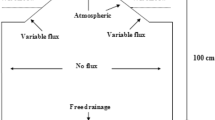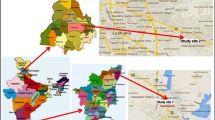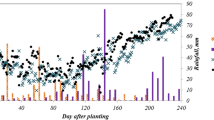Abstract
Boro rice, an emerging low-risk crop variety of rice, cultivated using residual or stored water after Kharif season. To enhance the quality and production of rice, potassium (K) and phosphorus (P) are the common constituents of agricultural fertilizers. However, excess application of fertilizers causes leaching of nutrients and contaminates the groundwater system. Therefore, assessment and optimization of fertilizer dose are needed for better management of fertilizers. Towards this, the present study determines the path, persistence, and mobility of K and P under the Boro rice cropping system. The experimental site consisted of four plots having Boro rice with four different fertilizer doses of nitrogen (N), P, K viz. 100%, 75%, 50%, and 25% of the recommended dose. Disturbed soil samples were analysed for K and P from pre-sown land to tillering stage at 0–5, 5–10, 10–15, 15–30, 30–45, and 45–60 cm depths. Simultaneously, K and available P were also simulated in the subsurface soil layers through the HYDRUS-1D model. The statistical comparisons were made with RMSER, E, and PBIAS between the modelled values and laboratory-measured values. Although, the results showed that all the treatments considered had agreeable simulations for both K and P, the K simulations were found to be better as compared to P simulations except for 25% where P simulations outperformed K. The simulated concentration at all doses was found most appropriate when measured for the subsurface layers (up to 45 cm), while showed an underestimation in the bottom layers (45–60 cm) of soil.










Similar content being viewed by others
References
Behera, S., & Panda, R. (2011). Assessing soil and groundwater contamination with HYDRUS-1D: A study from West Bengal. Environmental Quality Management, 20(3), 59–75.
Benedetti, M. F., Van Riemsdijk, W. H., Koopal, L. K., Kinniburgh, D. G., Gooddy, D. C., & Milne, C. J. (1996). Metal ion binding by natural organic matter: from the model to the field. Geochimica et Cosmochimica Acta, 60(14), 2503–2513.
CO, A., et al. (2011). Rice production and water use efficiency for self-sufficiency in Malaysia: A review. Trends in Applied Sciences Research, 6(10), 1127–1140.
De Datta, S. (1986). Improving nitrogen fertilizer efficiency in lowland rice in tropical Asia. In Nitrogen economy of flooded rice soils (pp. 171–186). Berlin: Springer.
Ernani, P. R., Dias, J., & Flore, J. A. (2002). Annual additions of potassium to the soil increased apple yield in Brazil. Communications in Soil Science and Plant Analysis, 33(7–8), 1291–1304.
Feddes, R., Kowalik, P., & Zaradny, H. (1978). Simulation of field water use and crop yield. Simulation monographs (pp. 9–30). Wageningen: Pudoc.
Freiberger, R. P., Heeren, D. M., Eisenhauer, D. E., Mittelstet, A. R., & Baigorria, G. (2018). Tradeoffs in model performance and effort for long-term phosphorus leaching based on in situ field data. Vadose Zone Journal, 17(1), 1–12.
Garg, N., & Gupta, M. J. I. S. (2015). Assessment of improved soil hydraulic parameters for soil water content simulation and irrigation scheduling. Irrigation Science, 33(4), 247–264.
Gupta, M., Garg, N., Joshi, H., & Sharma, M. (2012). Persistence and mobility of 2, 4-D in unsaturated soil zone under winter wheat crop in sub-tropical region of India. Agriculture, Ecosystems & Environment, 146(1), 60–72.
Gupta, M., Garg, N., Joshi, H., Sharma, M. J. E., et al. (2014a). Assessing the impact of irrigation treatments on thiram residual trends: Correspondence with numerical modelling and field-scale experiments. Environmental Monitoring and Assessment, 186(3), 1639–1654.
Gupta, M., Srivastava, P. K., Islam, T., & Ishak, A. M. B. J. E. E. S. (2014b). Evaluation of TRMM rainfall for soil moisture prediction in a subtropical climate. Environmental Earth Sciences, 71(10), 4421–4431.
Haefele, S., Konboon, Y., Wongboon, W., Amarante, S., Maarifat, A., Pfeiffer, E., et al. (2011). Effects and fate of biochar from rice residues in rice-based systems. Field Crops Research, 121(3), 430–440.
Hatfield, J., Edwards, O., & Dunn, R. (1966). Diffusion coefficients of aqueous solutions of ammonium and potassium orthophosphates at 25°. The Journal of Physical Chemistry, 70(8), 2555–2561.
Havlin, J. L., Tisdale, S. L., Nelson, W. L., & Beaton, J. D. (2016). Soil fertility and fertilizers. Chennai: Pearson Education India.
Haws, N. W., Rao, P. S. C., Simunek, J., & Poyer, I. C. (2005). Single-porosity and dual-porosity modeling of water flow and solute transport in subsurface-drained fields using effective field-scale parameters. Journal of Hydrology, 313(3–4), 257–273.
INTER, I. (2011). Toolkit for identification and quantification of mercury releases.
Keen, B. A., & Raczkowski, H. (1921). The relation between the clay content and certain physical properties of a soil. The Journal of Agricultural Science, 11(4), 441–449.
Khan, A. A., Jilani, G., Akhtar, M. S., Naqvi, S. M. S., & Rasheed, M. (2009). Phosphorus solubilizing bacteria: Occurrence, mechanisms and their role in crop production. J agric biol sci, 1(1), 48–58.
Lal, B., Gautam, P., Panda, B., & Raja, R. (2013). Boro rice: a way to crop intensification in Eastern India.
Lallemand-Barres, A., & Peaudecerf, P. (1978). Investigation of the relationship between the value of the macroscopic dispersiveness of an aquifer medium, its other characteristics, and the measurement conditions—Bibliographic study. Bull BRGM Ser, 2(3), 4.
Lobo, V. M., Ribeiro, A. C., & Verissimo, L. M. (1998). Diffusion coefficients in aqueous solutions of potassium chloride at high and low concentrations. Journal of Molecular Liquids, 78(1–2), 139–149.
Masto, E. (2004). Soil quality assessment in maize-wheat-cowpea cropping system under long-term fertiliser USE. Division of Soil Science And Agricultural Chemistry Indian Agricultural.
Mathevet, T., Michel, C., Andreassian, V., & Perrin, C. (2006). A bounded version of the Nash-Sutcliffe criterion for better model assessment on large sets of basins. IAHS Publication, 307, 211.
Moterle, D. F., Kaminski, J., dos Santos Rheinheimer, D., Caner, L., & Bortoluzzi, E. C. (2016). Impact of potassium fertilization and potassium uptake by plants on soil clay mineral assemblage in South Brazil. Plant and Soil, 406(1–2), 157–172.
Nash, J. E., & Sutcliffe, J. V. (1970). River flow forecasting through conceptual models part I—A discussion of principles. Journal of Hydrology, 10(3), 282–290.
Nohra, J. A., Madramootoo, C., & Hendershot, W. (2004). Modeling phosphorus transport in soil and water. In 2004 ASAE annual meeting. American Society of Agricultural and Biological Engineers (p. 1).
Pawar, D., Shah, K. J. G. O. M. W. R. D., Directorate of Irrigation Research, & Development, P. (2009). Laboratory testing procedure for soil and water sample analysis.
Qiao, S. Y. (2014). Modeling water flow and phosphorus fate and transport in a tile-drained clay loam soil using HYDRUS (2D/3D). Montreal: McGill University Libraries.
Salalia, R., & Walia, R. (2017). Effect of soil texture and water regimes on the pathogenicity of rice root-knot nematode, meloidogyne graminicola on rice. Indian Journal of Nematology, 47(1), 136–138.
Sarangi, S. K., Maji, B., Singh, S., Sharma, D. K., Burman, D., Mandal, S., et al. (2014). Crop establishment and nutrient management for dry season (boro) rice in coastal areas. Agronomy Journal, 106(6), 2013–2023.
Sekhon, G. (1999). Potassium in Indian soils and crops. Proceedings of Indian National Science Academy B, 65, 83–108.
Sikder, M. S., & Hossain, F. (2018). Improving operational flood forecasting in monsoon climates with bias-corrected quantitative forecasting of precipitation. International Journal of River Basin Management, 17, 1–11.
Šimůnek, J., Jarvis, N. J., Van Genuchten, M. T., & Gärdenäs, A. (2003). Review and comparison of models for describing non-equilibrium and preferential flow and transport in the vadose zone. Journal of Hydrology, 272(1–4), 14–35.
Šimůnek, J., & van Genuchten, M. T. (2008). Modeling nonequilibrium flow and transport processes using HYDRUS. Vadose Zone Journal, 7(2), 782–797.
Šimůnek, J., van Genuchten, M. T., & Šejna, M. (2008). Development and applications of the HYDRUS and STANMOD software packages and related codes. Vadose Zone Journal, 7(2), 587–600.
Singh, R. (2003). Harnessing Boro rice potential for increasing rice production in deepwater areas of eastern India: an overview. Boro Rice.
Srivastava, P. K., Singh, P., Mall, R., Pradhan, R. K., Bray, M., Gupta, A. J. T., et al. (2020). Performance assessment of evapotranspiration estimated from different data sources over agricultural landscape in Northern India, 1–12.
Teo, Y., Beyrouty, C., & Gbur, E. (1992). Nitrogen, phosphorus, and potassium influx kinetic parameters of three rice cultivars. Journal of Plant Nutrition, 15(4), 435–444.
Teo, Y. H., Beyrouty, C. A., Norman, R. J., & Gbur, E. E. (1995). Nutrient uptake relationship to root characteristics of rice. Plant and Soil, 171(2), 297–302.
Vilela, N., Thebaldi, M. S., Leal, B. D. P., Silva, A. V., & Martins, I. P. (2018). Transport parameters of potassium from different sources in soil columns. Engenharia Agrícola, 38(1), 135–141.
Walkley, A., & Black, I. A. (1934). An examination of the Degtjareff method for determining soil organic matter, and a proposed modification of the chromic acid titration method. Soil Science, 37(1), 29–38.
Zotarelli, L., Dukes, M. D., Romero, C. C., Migliaccio, K. W., & Morgan, K. T. (2010). Step by step calculation of the Penman–Monteith evapotranspiration (FAO-56 method). Florida: Institute of Food and Agricultural Sciences, University of Florida.
Acknowledgements
The authors thank the University Grant Commission for financial support. Authors are also thankful for SAP funding provided by UGC to the Department of Agronomy, Institute of Agricultural Sciences, Banaras Hindu University. The authors also acknowledge Institute of Environment and Sustainable Development, Banaras Hindu University for providing the necessary laboratory support for the study.
Author information
Authors and Affiliations
Corresponding author
Ethics declarations
Conflict of interest
None.
Additional information
Publisher's Note
Springer Nature remains neutral with regard to jurisdictional claims in published maps and institutional affiliations.
Rights and permissions
About this article
Cite this article
Gupta, A., Gupta, M., Srivastava, P.K. et al. Subsurface nutrient modelling using finite element model under Boro rice cropping system. Environ Dev Sustain 23, 11837–11858 (2021). https://doi.org/10.1007/s10668-020-01144-8
Received:
Accepted:
Published:
Issue Date:
DOI: https://doi.org/10.1007/s10668-020-01144-8




